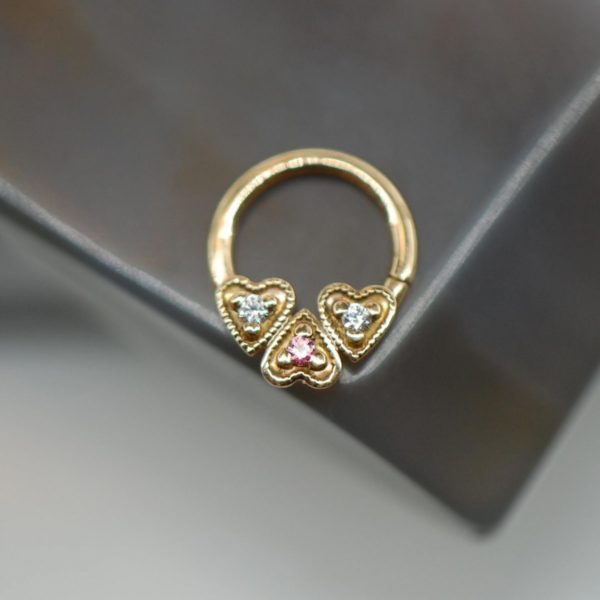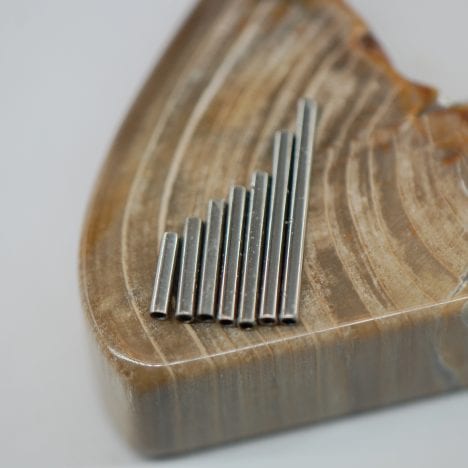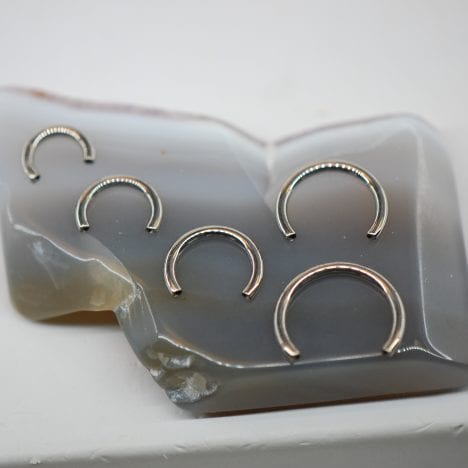One of the most frequent things we hear as piercers is “I got pierced with the really good stuff, you know, surgical stuff!” It’s also one of the most incorrect, misinformed statements we hear. So we decided to sit down and share some facts and education about metal, and why the material (and other factors) of what you wear make such a huge, huge difference to your piercing healing, and being happy and healthy!
The big thing we hear is “Surgical Steel”! I got pierced with “surgical steel”. But what does this term mean? Surgical stainless steel is a blanket term that is commonly used to refer to any steel used in medical or bio medical procedures or processes. But there is no formal definition or standard for surgical steel, so manufactures, companies, and other studios can use the term to refer to -any- kind of corrosive resistant steel. Any quick internet search for “surgical steel” pulls up things like toasters, pots and pans, tire rims, doorknobs, silverware, and tables. All these different products being sold to us as “surgical steel”. The catch here is the word “surgical” makes us think it’s safe. If they use it in surgery- it must be safe right? But there’s no real, concrete definition for surgical steel. So what someone is selling you could be any one of hundreds of metal alloys, containing who-knows-what, which can cause negative reactions for your piercings health.
Here at Amato the jewelry we use is Implant Grade. Implant grade mean ASTM-F136 ELI for titanium and ASTM-F138 316-LVM for steel. ASTM is an organization that sets forth standards for a wide range of materials, many with medical and biomedical purposes. The “F” spec designates metals for use in medical applications. The “VM” for steel stands for vaccum-melted. This process not only removes impurities in the metal, but allows for a better surface finish. With implant grade steel this is important because it actually creates a surface layer which can prevent nickle from leeching into the body. The “ELI” with titanium stands for Extra Low Interstitial, a stronger grade of metal commonly used in long term medical implantation like spinal surgeries, hip repair, and other joint repairs. Implant grade jewelry MUST meet these standards set forth by the ASTM and our companies need to prove it with documents called Mill Certificates which show the information about the metal. Meaning unlike “Surgical Steel” we can’t just market any range of alloys or mixtures to you- we must work within those specific standards. Beyond that we as a studio choose to work with American manufactures for our titanium, since Mill Certificates in other countries can sometimes be faked.
So what does this mean for your piercings? Well, mystery metals like “surgical Steel” are often non-compliant with the ECC Nickle Directive. Because Nickle is a known sensitizer (meaning people become more sensitive through contact) the European Union in 2009 regulated the amount of nickle that’s considered “acceptable” to be released from jewelry and other products that come in close contact with the skin. Most people become exposed to nickle heavily as children through body jewelry, and as you age that sensitivity can turn into contact dermatitis. For your piercings, it can also mean prolonged, problematic healing, and potential failure of the piercing. Nickle reactions are one of the most common issues we see in piercings, from dry exfoliating skin, to irritation bumps, or worse- migration and rejection. For this reason we as a studio have phased out any stock of steel jewelry,even implant grade. It’s not as common, but we have seen clients react poorly to implant grade steel. We keep a very small stock for clients who still prefer it, but generally we only use titanium these days because we don’t feel there’s -any- acceptable amount of a sensitizing metal to be worn.
“Ok- but if we know it’s bad, why is it still legal? Why can places sell me this stuff and tell me it’s safe?” Well, the same reason cigarette sales are still legal, and McDonalds advertises as food- money. Nickle is significantly cheaper then the comparative metals, its easier to manufacture and work it, and you can make a much much greater profit from jewelry containing massive amounts of it. However, we believe in your well being- not your wallet. Here at Amato we only care about what’s in your best interest. That’s also why we write these articles- to help get this kind of information out to clients so they can make informed decisions with their bodies and ensure they are getting piercings with safe, healthy jewelry.
Thyssen, J. P., Linneberg, A., Menné, T. and Johansen, J. D. (2007), The epidemiology of contact allergy in the general population – prevalence and main findings. Contact Dermatitis, 57: 287–299.
“European Union Nickel Directive:
The Nickel Directive is only enforced in Europe and is not in effect anywhere else. As a result of various problems associated with nickel sensitisation on clothes and jewelry, the European Community (EC) Nickel Directive (76/769/EEC – now 94/27/EEC) was enacted on the 20th of July 1999, and became law in the EU on the 20th of January 2000. The directive was devised due to fears about allergic reactions and sensitisation to nickel, and has been designed to reduce any problems caused by this metal. There is no ambiguity. Any supplier saying this Directive is not law is misguided or ill-informed. It is the law and moreover, both the supplier and the piercer share the responsibility of ensuring that this legislation is enforced. The directive is a large and complex document, but can be simply put as follows:
- Items intended to come into contact with BROKEN skin are restricted to a mass of 0.05% nickel.
- Items intended to come into close and prolonged contact with skin are restricted to a release rate of 0.5ug/cm2week of nickel.
- 316L SURGICAL STEEL contains between 6-13% nickel and it does not conform to the first part of the Directive and it cannot, therefore, be used for fresh piercings. It can only be used after the healing process (also known as ‘epithelization’) has taken place, as replacement jewelry, since it does not release nickel.
- TITANIUM does not contain nickel but can attract it during the manufacturing process. This means that it does conform to the first part of the Directive, but may not conform to the nickel release directive, depending on the standards of the manufacturer.
EU Nickel Directive 76/769/EEC”





